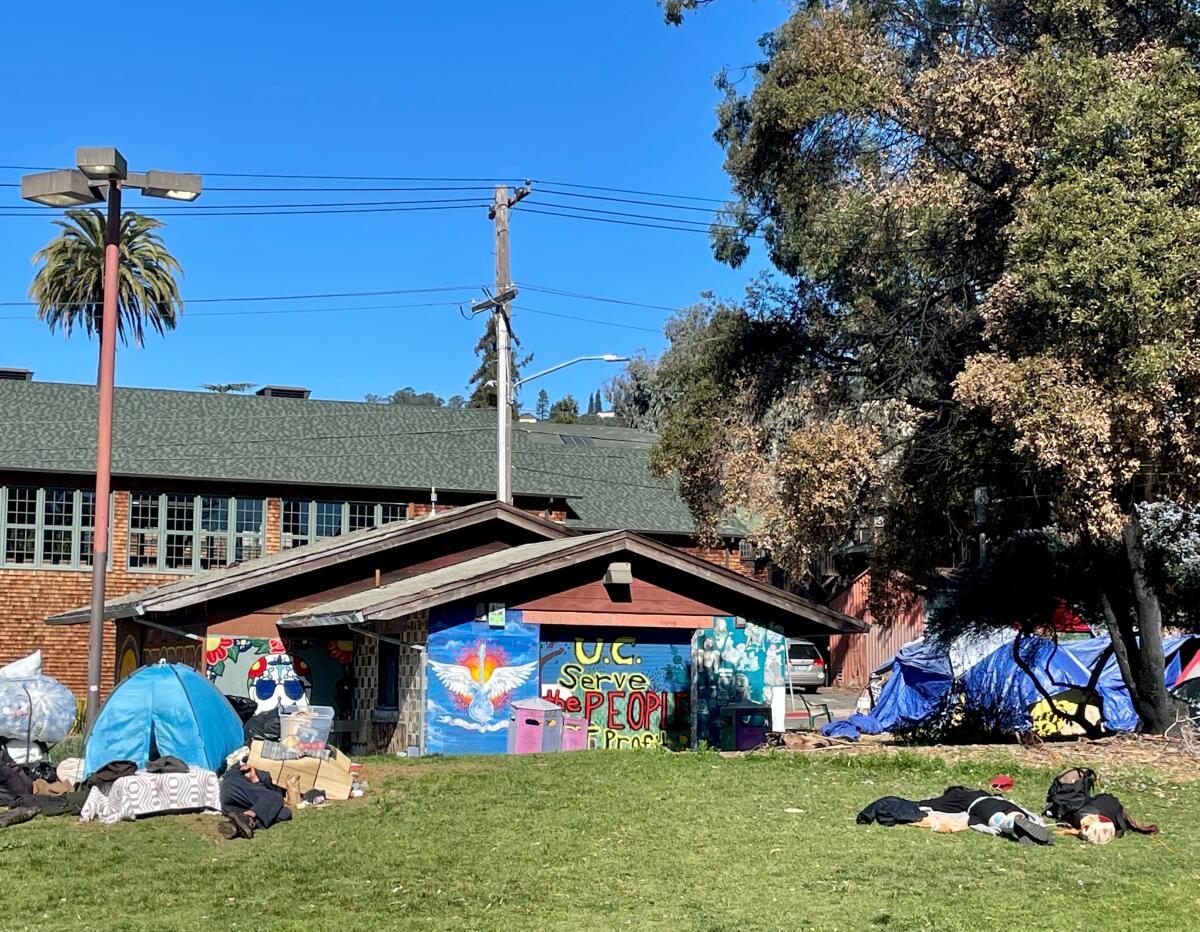How NIMBY abuse of a California law could keep thousands of kids out of UC Berkeley

- Share via
Early in my marriage, I purchased an ornate mirror, more gilt than glass, that I thought might be so ugly it could actually seem beautiful.
It was not. My husband promptly dubbed it the Shield of Zoltran, a made-up name (riffing on a cartoon) meant to highlight its absurdity. He demanded I return the mirror or face divorce.
The California Environmental Quality Act, or CEQA, has become California’s Shield of Zoltran, reflecting back our ugliest tendencies under the guise of environmentalism and offering protection for those who want to stop development for reasons that often distill down to self-interest — no matter how much gilt gets slapped around their arguments.
Though its original crafters had the best of intentions — Ronald Reagan was the governor who signed it into law — it has been misused over a half-century, morphing into a favorite weapon for maintaining the statewide status quo, and, in so doing, crushing equity.
Case in point: Berkeley.
As my colleague Teresa Watanabe reported Monday, UC Berkeley might be forced to cut more than 3,000 students from its fall enrollment because of a CEQA lawsuit. That’s the trampled ambitions of 3,000 high school seniors and transfer students, many people of color, that have somehow pushed through the hardships of the pandemic to maintain the grades, jobs, extracurriculars and everything else needed to be competitive at one of the state’s top public schools.
UC Berkeley said it will likely send out 5,000 fewer acceptance letters, messaging prospective students Monday that the school needs to make fewer offers to ensure that fewer people say yes.
The ruling by an Alameda County Superior Court judge stems from a community group’s lawsuit arguing that the university’s expansion plan doesn’t do enough to mitigate the traffic, noise, housing prices and, of course, effect on the environment, that more students would cause. The suit started over a proposed complex for the north side of campus that would have demolished an existing parking structure and built 150 units of housing for young faculty with families and graduate students, along with a four-story academic building for the nearby school of public health.
UC Berkeley may be forced to slash its incoming undergraduate class by one-third, or 3,050 seats, and forgo $57 million in lost tuition.
The community group, which told Watanabe it isn’t opposed to the project itself, sued to stop it based on the larger — not directly relevant — issue that the university was growing beyond numbers it had projected years ago. The group argued that growth would be a violation of CEQA if allowed to move forward without review. The court agreed.
It is the first time a court has ruled that admissions numbers are covered by CEQA — treating increased student enrollment little different than a proposal to build a structure — a precedent that almost assuredly will travel throughout the California college system, and possibly K-12 schools as well, if it stands.
The UC Board of Regents asked the court to lift the admissions cap (which was based on low pandemic-year enrollment numbers, making it even more devastating) while the case winds itself through the system, but it was denied. The board is trying to appeal to the state Supreme Court, asking it to make a ruling quickly if it takes the case. For the thousands of kids who dream of going to Berkeley next year, this is an urgent issue — most admission letters are set to go out in March. Multiple people told me it was unlikely the Supreme Court would step in. We’ll see.
Assembly member Kevin McCarty (D-Sacramento), who has long championed both increasing slots for California kids to attend California colleges and building student housing, called the lawsuit and the freeze “mindboggling” and “frustrating.” He said it is a legal overreach by entitled residents who seem to want the benefits of a university community without any burdens.
John A. Pérez, former chair of the Board of Regents, called the admissions halt a tragedy. Pérez, who made it clear he was speaking only as a former legislator, said Berkeley’s suit was NIMBYism no different from Woodside’s recent attempt to declare itself a sanctuary for mountain lions in order to avoid allowing affordable housing.
Craven and transparent — my words, not his.
CEQA is a law constantly under attack by developers and others who chafe under its cumbersome rules, but it becomes harder to protect it when it’s abused in this way, Pérez argued. That may be the second tragedy of this lawsuit: endangering a key legal tool to grow sustainably and responsibly.
I am a big fan of CEQA when it’s used for its intentions: protecting our environment, including countering climate change and guarding low-income communities that for too long have borne the brunt of pollution and neglect. The law, in my view, could be strengthened to ensure that there are more environmental justice protections in the places where powerful industries are building large-impact facilities, such as warehouses.
CEQA does a lot of good, and when pet projects are randomly given exemptions from the law, those exemptions can do a lot of harm. SoFi Stadium is an example. Designed and built without a full environment impact review, it now lacks connections to public transit, a costly oversight that will force Inglewood and other communities to finance fixes out of their own pockets.
Multiple studies have found that the rate of CEQA lawsuits is actually low. It is not abused as often as it seems. Over nearly 20 years of data, an average of 195 CEQA lawsuits have been filed each year. In recent years, that translates to less than 2% of public building projects being subject to a CEQA lawsuit, according to a recent report by the Housing Workshop, commissioned by the Rose Foundation for Communities and the Environment.
But what those 195 lawsuits target should be better understood, and there should be ways for courts to better determine early on if a case is deploying the law fairly. Some neighborhoods are using CEQA over and over as a cudgel to slow housing development during a housing crisis. That needs to stop.
Dan Mogulof, a spokesman for UC Berkeley, points out that groups have sued the university multiple times when it has attempted to increase housing and facilities — including another pending CEQA lawsuit that’s trying to block construction of beach volleyball courts for the women’s team, as required under Title IX laws. Some of the same people suing over the faculty housing project are involved in the volleyball dispute, Mogulof said.
Meanwhile, UC Berkeley needs 8,000 beds in new housing to be able to offer every student two years of on-campus accommodations — a reality that Mogulof said will require it to build on “every single piece of land the university owns [near campus] and then some.” This includes the iconic People’s Park, where, you guessed it, a lawsuit has been filed to stop a project that would house 1,100 students and 125 unsheltered people.

The state has already allotted billions to help colleges and universities pay for housing (and universities bear much blame for not moving sooner and more urgently), and McCarty is pushing for billions more, because Berkeley is no anomaly. Students across California’s colleges are living in cars, packed into houses and, in too many cases, attending school while homeless.
Critics argue that UC Berkeley recruits too many international students, and while that downplays the value these kids bring to California and the UC system, there’s an argument to be made that a larger share of admissions should be reserved for in-state students.
But people shouldn’t live in college towns if they don’t want college students around. Berkeley today isn’t the Berkeley of the 1960s, which is painfully obvious, but it’s also not the Berkeley of 2030 and beyond. We are a growing state, with growing needs. That means dormitories will need to be built in neighborhoods near the stately old homes.
California kids deserve to go to California schools, as do candidates from other places who will add to our diversity and strength. Using an environmental law to smash those hopes can’t be mistaken for anything but ugly.
More to Read
Sign up for Essential California
The most important California stories and recommendations in your inbox every morning.
You may occasionally receive promotional content from the Los Angeles Times.
















